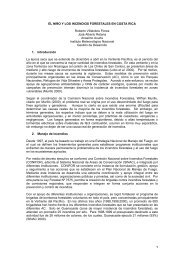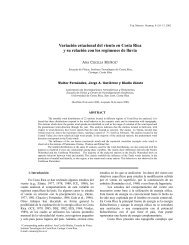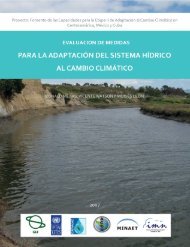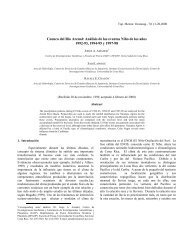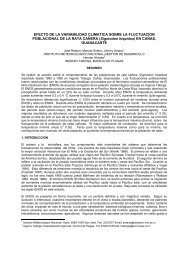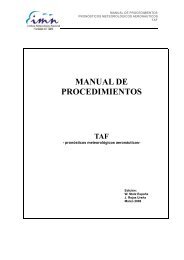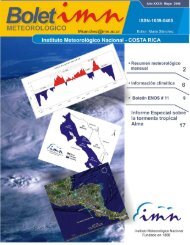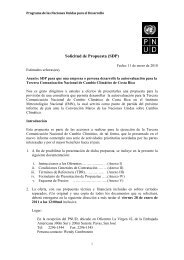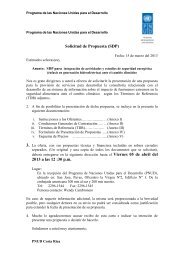Page 2 Editora: Dra. Gladys Jiménez Valverde Director de ...
Page 2 Editora: Dra. Gladys Jiménez Valverde Director de ...
Page 2 Editora: Dra. Gladys Jiménez Valverde Director de ...
- No tags were found...
Create successful ePaper yourself
Turn your PDF publications into a flip-book with our unique Google optimized e-Paper software.
TÓPICOS METEOROLÓGICOS Y OCEANOGRÁFICOS 53ingresan a la región <strong>de</strong> estudio. Valores negativos <strong>de</strong>la AO favorecen temporadas altas en el número <strong>de</strong>EF´s y viceversa. Cuando la AO experimenta periodosnegativos prolongados y magnitu<strong>de</strong>s importantespor algún lapso, las temporadas resultan con unmayor número <strong>de</strong> EF´s profundos latitudinalmente yviceversa.Llama la atención que en términos <strong>de</strong> la hora<strong>de</strong> entrada <strong>de</strong> los EF´s al norte <strong>de</strong> Belice, haypredominancia <strong>de</strong> entrada hacia la media noche (06UTC) e inicio <strong>de</strong> la mañana, disminuyendo hacia elmedio día y el atar<strong>de</strong>cer. No queda claro si esto esun resultado meramente casual o si está relacionadocon alguna característica invernal entre la península<strong>de</strong> Yucatán y el Golfo <strong>de</strong> Méjico.Es interesante notar que 5 <strong>de</strong> las 8 temporadasricas en EF´s profundos i<strong>de</strong>ntificadas en el estudio,se ubican <strong>de</strong> la temporada 1999-2000 en a<strong>de</strong>lante,cuando las anomalías <strong>de</strong> las temperaturas árticasalcanzan y sobrepasan sostenidamente el valor <strong>de</strong>0,5°C y el valor <strong>de</strong> las anomalías <strong>de</strong>l promedio móvil<strong>de</strong> doce meses <strong>de</strong> los hielos marinos árticos, se tornanegativo, también sostenidamente. A<strong>de</strong>más, a partir<strong>de</strong> dicha temporada, solamente una, la <strong>de</strong> 2006-2007fue pobre en penetraciones profundas.En temporadas <strong>de</strong>ficitarias en cuanto al número <strong>de</strong>EF´s, el suroeste <strong>de</strong>l Caribe y sur <strong>de</strong> Centroaméricano necesariamente se quedan sin lluvias, ya queexisten otros mecanismos importantes que tambiénlas producen, tales como el Chorro <strong>de</strong> Bajo Nivel <strong>de</strong>lCaribe y las vaguadas prefrontales.ReconocimientoSe agra<strong>de</strong>ce la revisión <strong>de</strong>l trabajo, sus valiososcomentarios y señalamientos a las siguientespersonas: Dr. Walter Fernán<strong>de</strong>z Rojas <strong>de</strong> la Escuela<strong>de</strong> Física <strong>de</strong> la Universidad <strong>de</strong> Costa Rica; Especialistaen Meteorología Werner Stolz España, <strong>de</strong>l InstitutoMeteorológico Nacional <strong>de</strong> Costa Rica y al Licenciadoen Meteorología Luis Fernando Alvarado Gamboa,<strong>de</strong>l Instituto Meteorológico Nacional <strong>de</strong> Costa Rica.5. ReferenciasAmador, JA. (1998). A climatic feature of the tropicalAmericas: The tra<strong>de</strong> wind easterlyjet. Tópicos Meteorológicos yOceanográficos 5(2):1–13.Amador, JA. & Magana, V. (1999). Dynamics of thelow level jet over the Caribbean Sea.Preprints, the 23rd conference onhurricanes and tropical meteorology,American Meteorological Society,Dallas, pp 868–869.Baldwin, M. (2010). Annular mo<strong>de</strong>s in global dailysurface. Geophysical ResearchLetters. Vol. No. 21, pages 4115-4118,November 1, 2001. Recuperado <strong>de</strong>http://www.nwra.com/resumes/baldwin/pubs/Baldwin_GRL2001.pdf.Chiang, J.C.H.; Biasutti, M. & Battisti, D.S. (2003).Sensitivity of the Atlantic IntertropicalConvergence zone to last glacialmaximum boundary conditions.Paleoceanography, 18 (18–1), 1094.doi:10.1029/2003PA000916.Climatic Research Unit (CRU), University of East Anglia,(2012). Temperature in Polar Regions:Arctic and Antarctic. Recuperado <strong>de</strong>:http://www.climate4you.com/in<strong>de</strong>x.htmChylek, P.; Folland, CK.; Lesins, G.; Dubey, MK. & Wang,M. (2009). Arctic air temperaturechange amplification and the AtlanticMulti<strong>de</strong>cadal Oscillation. GeophysicalResearch Letters. Vol. 36, L14801,doi:10.1029/2009GL038777.Manak, DK. & Mysak, LA. (1989). On the relationshipbetween arctic sea‐ice anomalies andfluctuations in Northern Canadianair temperature and river discharge.Atmosphere-Ocean. 27:4, 682-691.



